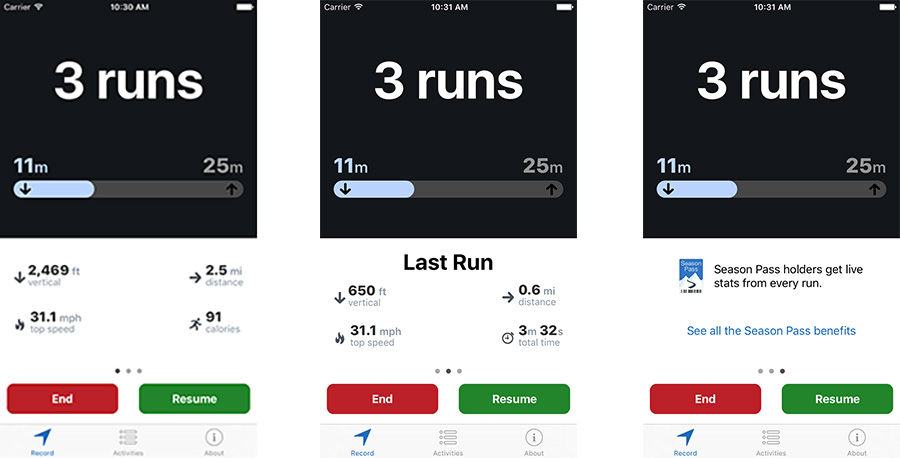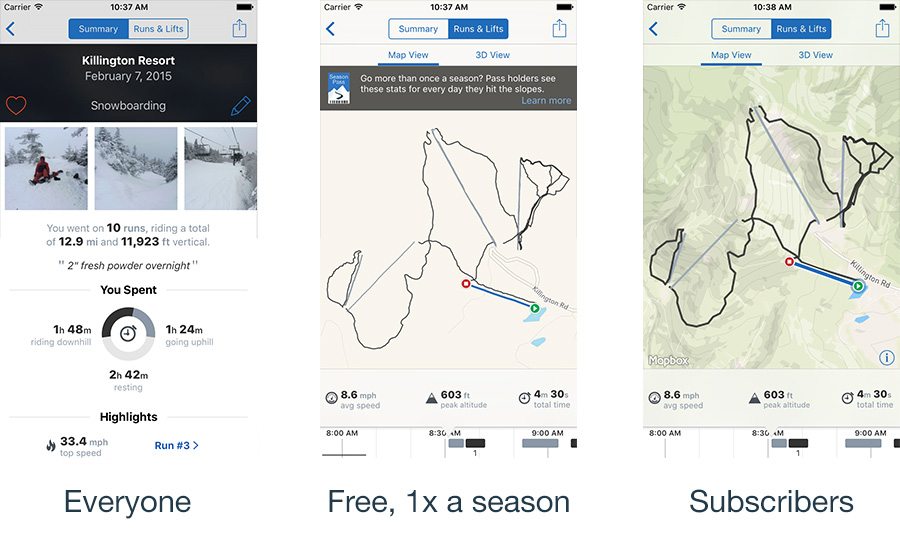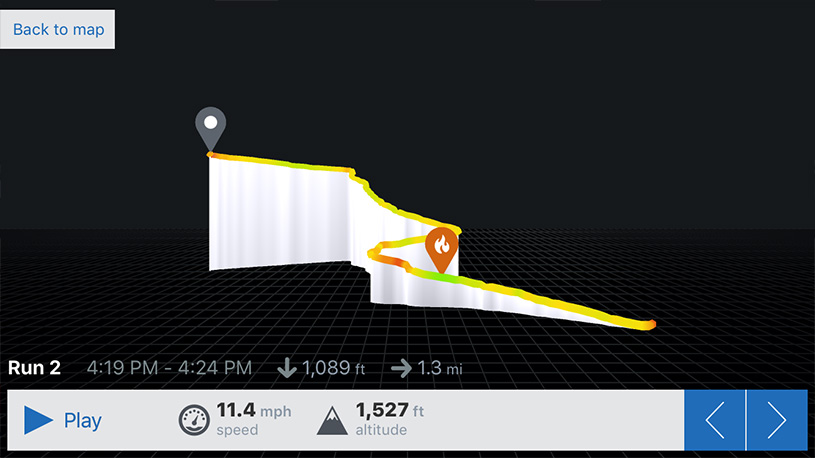Slopes Diaries #4: The Great Wall
Slopes Diaries is my ongoing journey to turn my indie app into a more sustainable part of my business. First time reading? Catch up on the journey so far.
What is Slopes? Think Nike+, Runkeeper, Strava, MapMyRun, etc for skiers and snowboarders.
It should be no surprise after the last post that I'm trying a subscription model for Slopes 2.
Enter the Slopes Season Pass.
I think subscriptions aligns users' and my interests as a business owner, sets good expectations on future fees, and lets me give away something akin to a free trial if I'm clever about how I build my subscription wall. It also aligns with existing aspects of my niche: users already understand the concept of yearly passes to their favorite ski resorts.
A successful free with in-app purchase / subscription model is all about finding an important balance: enough free features attract downloads and be sticky, but a compelling enough paid offer to drive an OK conversion rate to subscriptions from those downloads. This balance is often cited as the reason freemium apps fail to make revenue. We all think we're clever enough to have cracked it for our market, myself included, but it's tricky and easy to mess up.
I had an interesting ah-ha moment over the summer as I was working through finding this balance, and it helped everything fall into place for me.
Redefining My Market
The market for Slopes is skiers and snowboarders who go to the mountain a few times a year, enough to consider themselves passionate about the sport, and therefore care enough to buy an app for it, right?
That's how I used to think, when I was paid up front.
Turns out though, going forward, that's only my target paying market. My target market actually includes families who go up for one weekend a year to ski, and people just learning but are unsure if they'll continue with the sport. People who would never have even thought to look for an app like Slopes, let alone place any value on it.
Once I realized I had this natural division in my target market, amateurs vs enthusiasts, everything started to fall in place. It wasn't some random decision on what to make users pay for anymore. If an enthusiast would really want/need the feature, but an amateur probably wouldn't, it was a paid feature.
I'm really glad I had this ah-ha moment, otherwise I would have made a similar mistake to one of my competitors.
One of the mistakes I think my free with subscription competitor made was how they approached what was a premium feature and what was free. They were thinking like I used to, where their target user were the enthusiasts, and the free app had to be useful enough for them. Having a subscription in their app would unlock a very small set of advanced stats, leader board filtering, and a few other cool things, but the unpaid version of the app was actually good enough for the majority enthusiasts hitting the mountain dozens of times a year.
(Some users even realized a lot of the advanced stats were available through their web profile, regardless of paying for a subscription, and encouraged others to avoid the subscription and just look 'em up that way. Oops.)
It's a lot harder to sell a user on upgrading from the free version when they aren't feeling any pain. They need to hit some walls, cool features aren't enough.
Growing with the User
I wanted to make sure I wasn't just relying on cool features alone to entice people to subscribe in Slopes. I like services that also work an aspect of frequency-of-use into the business model. The more a user uses the service, the more likely they are to hit some limits and need to buy into supporting the app.
Evernote is a good example of this model; they unlock enticing features like offline editing as you move into the paid tiers, but they also increase the about of data you can add to your notes (images, etc). Heavy Evernote users are going to have to move into the paid tiers even if they never need something like offline editing.
This approach makes sure it isn't just your power-users that want to pay, but also your heavy users. And I think that's fair -- power users cost dev time to add new features, while heavy users increase the server-side costs and potential support issues.
Done right, a usage-based business model can also be a natural way to let free users see the power of a paid subscription.
Putting All This Together
So with these ideas in mind, how did I structure things in Slopes 2? Lets look at 2 main sections of the app really quick, starting with the recording screen.
When a user is recording their day Slopes is usually a silent friend just hanging out in their pocket. Occasionally a user takes a quick snack break and they want to check their stats, mostly out of curiosity, asking "what was my top speed for the day?" or "how long did I spend on lifts vs going downhill?" These are high level questions that even amateurs would ask.
However, enthusiasts are going to want more data at a time like this. They're going to want run-by-run breakdowns of their stats that they can browse through. They probably want to compare stats from their last few runs.

I don't think this feature division is the strongest sell for my subscription, it certainly couldn't stand on its own, but I wanted to make sure the recording section came with an advantage for subscribers in order to help build my case for subscription sales.
My strongest sell is in what comes after they're done for the day. That's where I found ways to apply the lessons I got from services like Evernote into my own app.
Slopes has two main recap screens: a high-level summary, and a detailed breakdown run and lift map screen.
Most amateurs are just going to care about the high level things: how fast did they go, how far, maybe save in a picture or two, but that's it. They might find a run and lift breakdown map cool, but they won't feel any pain in missing it. Enthusiasts, however, are going to absolutely want a breakdown screen, so I have a pretty natural division in my market to plan around here.
This breakdown screen is one of the key unique features of Slopes and I need to be able to show it off to everyone. With my market division in mind, how can I apply the concept of making more active users want to buy a subscription, and how can I give a taste of the subscriber-only features here without angering Apple and their rules surrounding time trials or demos?
Think back to what I said earlier: a good chunk of my new target market only makes it to the mountain once a year, and those users are unlikely to care enough to buy a subscription. So why not make my breakdown always available for the first recorded session of every season?

Now everyone gets a free trial of one of the most powerful and unique subscription features in Slopes. Even amateurs find the feature pretty cool to play with, and now they're able to show it off to their friends to help with word of mouth.
I do hold one feature of this screen back for subscribers only: free users are stuck on Apple Maps, whereas subscribers get access to Mapbox and the custom map I designed to highlight terrain features (again, something enthusiasts will crave).
This trial idea easily extended to another key Slopes feature. If you rotate your phone on the run and lift screen you get a 3d version of each run that you can replay to see your speed / altitude as you virtually go down the mountain. Again, a really compelling feature that I want everyone to try, but something enthusiasts are going to be most interested in. So the 3d feature follows the same rules as the map does: free once a season, paid after that.

I'm really glad I had that ah-ha moment. I don't think my balance of free vs paid would be nearly as compelling if I didn't discovered a new way to frame building my wall: amateur skiers vs enthusiasts.
I believe Slopes 2 is a compelling free app for amateurs, and yet has enough awesome paid features enthusiasts will want to drive conversions. I'm feeling pretty good about not giving away too much for free, but also not being a greedy developer and pay-walling everything (a feeling I would have had if my target market was just enthusiasts). I'm taking advantage of a division in my target market to segment my users, and build my business model around that.
As of last night Slopes 2 is submitted to Apple for review. Assuming all goes well I hope it'll be out in the next two weeks. With the core of my subscription model in place, this winter is now focused on 1) driving new users to the app and 2) conversions to subscriptions.